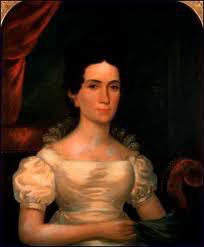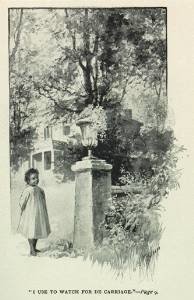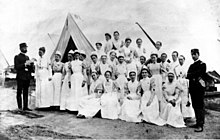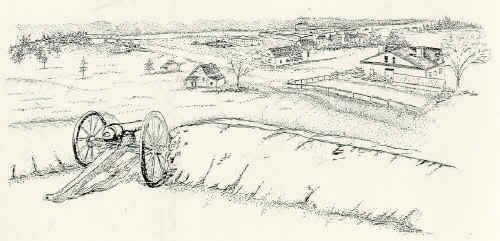10th First Lady of the United States
Letitia Tyler (1790–1842), first wife of President John Tyler, was First Lady from April 4, 1841 until her death on September 10, 1842. After giving birth to eight children in fifteen years, Letitia Tyler suffered a stroke, which left her unable to walk. Yet her poor physical health did not prevent her from overseeing her family’s successful Virginia plantation and raising their children. In fact, it was Letitia’s success in these roles throughout their married life that allowed John Tyler to pursue his political ambitions full time.
Childhood and Early Years
Letitia Christian was born on November 12, 1790 on a Tidewater Virginia plantation named Cedar Grove in New Kent County, about twenty miles from Richmond. She was the daughter of Colonel Robert Christian, a prosperous planter, and Mary Brown Christian. Letitia was described as shy, quiet, pious, and by all accounts utterly selfless and devoted to her family.
Letitia had more in common with Martha Washington and Martha Jefferson than the younger First Ladies. Formal education was not part of the rural Virginia pattern of life, but Letitia learned all the skills of managing a plantation, rearing a family and presiding over a home, believing this was all a female needed.
John Tyler
John Tyler was born on March 29, 1790, in the early years of the newly established nation. Tyler was raised with his two brothers and five sisters on Greenway Plantation, a 1,200-acre estate with a six-room mansion in Charles City County. After graduation from the College of William and Mary, he studied law with his father, who was a state judge at the time.
At the time of their marriage Tyler was serving in the Virginia House of Delegates, and served there until 1816, when he was elected to the US House of Representatives, 1817-1821. In 1825 he was elected Governor of Virginia, 1825-1826; United States Senator, 1827-1836; Vice President of the United States in 1841; then he assumed the Presidency in April 1841 after William Henry Harrison died after one month in office.
Marriage and Children
In 1808 Letitia met John Tyler, then a law student, at a private party on a nearby plantation. Their five-year courtship was so restrained that not until three weeks before the wedding did Tyler kiss her – and even then it was on the hand. Judging from Tyler’s surviving letters, the union was genuine and loving, but somewhat restrained by Letitia’s conservative and undemonstrative nature.
In his only surviving love letter to her, written a few months before their wedding, Tyler promised:
Whether I float or sink in the stream of fortune, you may be assured of this, that I shall never cease to love you.
They were married on March 29, 1813 – his twenty-third birthday – at Cedar Grove Plantation. Their 29-year marriage appears to have been a happy one. Thereafter, whether he served in Congress or as Governor of Virginia, Letitia attended to domestic duties. Only once did she join him for the winter social season in Washington.
Shortly after their wedding, Letitia’s parents died and she received a substantial inheritance. The couple used Letitia’s money to purchase a nearby plantation, then rapidly moved to increasingly larger houses: Mons-Sacer, Woodburn, then Greenway, John Tyler’s childhood home. Letitia supervised the 1,200 acre Greenway estate for many years.
Letitia’s inheritance and her success in running their plantations and raising their children also permitted Tyler to pursue his political career full time. Letitia rarely left home and played little role in her husband’s career due to the demands of her ever-expanding family which untimately numbered eight.
John and Letitia Tyler had four daughters and three sons live to maturity:
• Mary Tyler Jones (1815–1848) – married Henry Lightfoot Jones, a prosperous Tidewater planter.
• Robert Tyler (1816–1877) – lawyer, public official. Having served as his father’s private secretary in the White House, he settled in Philadelphia, where he practiced law. As a leader of the Democratic Party in Pennsylvania, Robert Tyler promoted the career of James Buchanan. At the outbreak of the Civil War, he returned to Virginia, where he served in the Treasury of the Confederacy. Penniless after the war, he settled in Montgomery, Alabama, where he regained his fortunes as a lawyer, editor of the Montgomery Advertiser and leader of the state Democratic Party.
• John Tyler, III (1819–1896) – lawyer, public official. Like his older brother, he also became a lawyer, served as private secretary to his father and campaigned for James Buchanan. During the Civil War, he served as assistant secretary of war of the Confederacy. After the war, he settled in Baltimore, where he practiced law. Under the Grant administration, he was appointed to a minor position in the IRS in Tallahassee, Florida.
• Letitia Tyler Semple (1821–1907) – educator. In 1839, she married James Semple, whom her father appointed a purser in the U.S. Navy. The marriage was an unhappy one. At the close of the Civil War, she left her husband to open a school, the Eclectic Institute, in Baltimore.
• Elizabeth Tyler Waller (1823–1850) – At a White House wedding in 1842, she married William N. Waller. She died from the effects of childbirth at age 27.
• Alice Tyler Denison (1827–1854) – In 1850 she married the Reverend Henry M. Denison, an Episcopal rector in Williamsburg. She died suddenly of colic at age 27.
• Tazewell Tyler (1830–1874) – doctor. During the Civil War, he served as a surgeon in the Confederate army. After the war, he moved to California.
Letitia Tyler avoided the limelight during her husband’s political rise, raising her children and overseeing the running of their homes. It would seem that she accepted slavery as part of plantation life, she insisted that no women slaves be permitted to do outdoor work of any kind. More often than not, the Tylers experienced financial difficulties and it was the primary source of stress, and it was she who assumed responsibility for the family’s investments.
For a period of about five years, however, she enjoyed some measure of her husband’s success. While he served as Governor of Virginia, she presided as the First Lady of Virginia in Richmond, from 1825 to 1827. As a US Senate wife, she spent the social season of 1828-1829 in Washington, DC, living in the capital at an exciting time of change from the last bitter months of the John Quincy Adams Administration to the raucous Inauguration of the first western President, Andrew Jackson.
After resigning from the U.S. Senate in 1836, Tyler returned home to Virginia. A few short years later, in 1839, at age 49 Letitia Tyler suffered a stroke which left her partially paralyzed and unable to get around easily.
How, or if Letitia Tyler’s influence applied to any of her husband’s political decisions is unknown but one daughter recalled:
I have frequently heard our father say that he rarely failed to consult her judgment in the midst of difficulties and troubles, and that she invariably led him to the best conclusion.
As chronicled in a letter written by her daughter-in-law in the years just prior to her moving into the White House, Letitia Tyler was still able to direct the management of her home and the entertaining that took place there with verbal instruction from her bedroom, despite the limitations on her health and movement as a result of her stroke.
In 1840, when Tyler was chosen as the vice presidential candidate to balance the ticket with Whig presidential candidate William Henry Harrison, the Tylers’ intent was to continue living in Virginia, with him occasionally commuting to Washington DC. Fate would not comply with their plans as Harrison died a mere month after taking office.
First Lady of the United States
The Tylers were at their home in Virginia when Fletcher Webster, the son of Secretary of State Daniel Webster and chief clerk of the State Department arrived, via the boat Osceola, with the news of Harrison’s death. Tyler immediately left for the capital city. When Tyler arrived in Washington, DC at 4:00 a.m. on April 6, 1841, he took the oath of office in his room at the Indian Queen Hotel.
Robert Tyler, serving as his father’s secretary, followed a week later with his wife Priscilla. The other Tyler children – married daughter Letitia Semple, single daughter Elizabeth, son John, Jr., younger daughter Alice, younger son Tazewell – came to Washington in late May and brought their mother Letitia Tyler with them. Married daughter Mary Jones remained in Virginia.
Letitia’s health had stabilized and she orchestrated the household affairs of the White House to a limited degree from the upstairs residence. While she largely remained seated in her second-floor room, her Bible, prayer book and knitting at her side, she took a lively interest in the activities of her young children, their spouses and her growing circle of grandchildren.
She was able to speak, often encouraging that the family must enjoy the social opportunities that came to them as the presidential family despite her inability to join them and she also directed that many charitable contributions be made from her own personal but limited wealth to the poor of Washington.
Letitia also apparently permitted special guests outside of the family in to see her, and had some interest in the world outside of her room, because she was remembered as being able to “converse with visitors on current topics, intelligently.” A remark that she “evaded the public eye as much as possible” suggests that she may have had more movement beyond her private quarters than has been previously supposed.
The First Lady did not attempt to take part in the social affairs of the administration. Her married daughters had their own homes; the others were too young for the full responsibility of official entertaining. Letitia was remembered as being “the most entirely unselfish person you can imagine… Notwithstanding her very delicate health, mother attends to and regulates all the household affairs and all so quietly that you can’t tell when she does it.”
In the face of her physical limitations and deteriorating health, Letitia Tyler still managed to assume many of the duties traditionally borne by the President’s ‘Lady’ – directing the White House social calendar, greeting callers, making visitors feel at home, and advising her husband on political affairs. Yet she did not perform the important and visible jobs associated with hostessing, nor did she direct a much-needed refurbishment of the White House.
Daughter-in-law Priscilla Cooper Tyler (wife of son Robert Tyler) served as the official hostess of the White House during the first three years of the Tyler Administration, from approximately April 1841 until March 1844. Intelligent and beautiful, with dark brown hair, Priscilla charmed the President’s guests – from visiting celebrities like Charles Dickens to enthusiastic countrymen – and enjoyed the expert advice of former First Lady Dolley Madison, who lived across the street.
Priscilla embraced her hostessing duties, holding two formal dinners a week when Congress was in session, providing biweekly evening receptions which were open to the public, and inviting as many as a thousand guests to her monthly parties. She opened up the White House on both New Year’s Day and the Fourth of July, and initiated summer Marine Band concerts on the south lawn of the White House.
The political turmoil of the Tyler Administration included two consecutive nights in August 1841 when a mob surrounding the White House with torches, banging drums, blowing horns, shouting epitaphs at the President and burning him in effigy to protest his veto of a bank bill; this protest only aggravated the delicate First Lady’s condition, and she worried constantly about the continuous drain on the family finances, since a stubborn Congress insisted that the President pay all expenses out of his own pocket.
As First Lady, Letitia Tyler came down from the upstairs living quarters and made her only intently public appearance in the state rooms of the White House as First Lady at the marriage of her daughter Elizabeth to William Waller on February 7, 1842, greeting her guests “in her sweet, gentle, self-possessed manner,” said Priscilla.
Sometime after the Waller wedding, the First Lady suffered a second stroke. She apparently was still able to speak, a letter that the President wrote to their daughter Mary Jones stated that the First Lady implored her to move to the White House or at least visit as soon as possible. This corresponds with another plea, in August of 1842, to see her son Robert and his wife Priscilla who were visiting her sister in New York.
The First Lady’s sister Elizabeth Douglas and her daughter Lizzie Waller arrived in Washington from their homes near Williamsburg, Virginia in time to see Letitia Tyler before she died. Robert and Priscilla, however, arrived too late; the First Lady had died, holding a rose in her hand, having continually turned to look for her son.
In her seventeen month as First Lady, Letitia Tyler died peacefully in the evening of September 10, 1842 at age 51, making her the youngest First Lady to die. As the first incumbent presidential wife to die, Letitia Tyler’s funeral was of considerable public acknowledgement. The White House was hung with black mourning bunting, and newspapers carried details of her death, funeral and burial plans.
Her coffin lay in state in the East Room, and the city’s bells were tolled in her honor. After a funeral in the East Room, the body of Letitia Tyler – accompanied by an “official committee of the citizens of Washington” – was sent to Richmond by train and brought back by carriage to her birthplace at Cedar Grove where she was buried.
Priscilla Cooper Tyler continued to serve as White House hostess, and most notably, accompanied her father-in-law on an official presidential tour during the summer of 1843. It was the first time that any President traveled the United States with a female member of his family as part of his official party, thus giving a previously unrecognized level of public visibility and status to the role of First Lady.
Priscilla Tyler was also the first official hostess to give birth during her tenure; her second child, Letitia, was born in the spring of 1843. In March of 1844, Robert and Priscilla Tyler moved to Philadelphia where Robert practiced law, and daughter Letitia “Letty” Tyler Semple served as her widowed father’s White House hostess and devoted companion.
In June 1844, Letty was shocked and hurt when her father married Julia Gardiner, a woman thirty years his junior. Letty was replaced as hostess by a woman younger than she. While the other Tyler children soon took to their new stepmother, Letty Semple never did. She divorced her husband, and spent an uncertain life thereafter.
In the 1870’s Letty Semple was given free room and board for the rest of her life by her friend, Washington entrepreneur W. W. Corcoran, at the Louise Home, which he created for elderly women of distinguished background who found themselves in genteel poverty. He was Letty’s escort to the numerous White House events she was invited to by First Lady Lucy Webb Hayes, and Hayes befriended and often visited Letty Semple at the Louise Home.
President John Tyler died on January 18, 1862 and was interred in Richmond’s Hollywood Cemetery with a grandiose funeral and the erection of an enormous marker. He died a Confederate and at his request his body was wrapped in a Flag of the South. When Julia Gardiner Tyler passed, she was interred beside him. Letitia was forgotten; her grave remains today in the brick walled cemetery at Cedar Grove Plantation.
SOURCES
Wikipedia: Letitia Christian Tyler
The White House: Letitia Christian Tyler
First Lady Biography: Letitia Tyler






